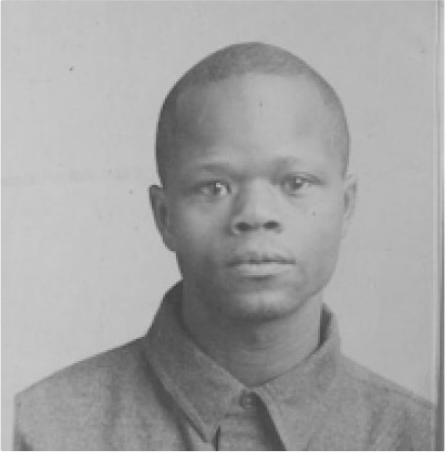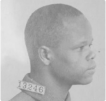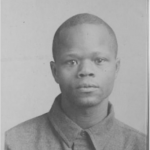Pvt. Charles J. Hattan
Charles J. Hattan was born in Accomac, Virginia on February 13, 1885. He enlisted with I Company in March 1912 and received an honorable discharge at the end of a three-year hitch in March 1915. He signed up for another enlistment in the army in April 1917 and rejoined 3/24 Infantry just four months before the Houston Incident. Records indicate that after he was released from prison he married Gertrude Wallace in July 1930 in New York City.
On Aug 27, 1922, while he was incarcerated at Leavenworth, Hattan wrote to Mrs. G.B. Goetz, president of the MN Dept. of the American Legion Auxiliary in his home state:
Dear Madam: I hope that I am not presuming too much asking your indulgence and time to hear my story as well as your co-operation in the work of investigating the justice of my claim. I wish to say in the outset that there are some embarrassing features connected with my case, the principal one being the inherent prejudices of the people of the South against the negro race, but without further preliminaries I shall endeavor to briefly state my case.
You are no doubt familiar with the current reports in 1917 of the Houston riots which was charged up to the 24th Infantry, U.S. army (colored) followed by three court martials which resulted in the summary [sic] execution of nineteen of these soldiers and sentencing of fifty-six to life terms in prison. No doubt but there were some whose punishment were merited, but the over jealousness [sic] of those in authority to satisfy the clamor of an excited populace, made it impossible for the authorities to deal equal and exact justice, to each individual. However much they may have desired to do so. I being one of those receiving life sentence I hope you will bear with me until I give you a brief summary of my life in so far as its [sic] connected with the unfortunate climax, under which I am now suffering. I am now thirty-seven years of age… I again enlisted in April 1917, which services terminated with this unfortunate affair; unfortunate for the reason that the innocent and guilty were made to suffer alike. My purpose in making this outline or brief biography is not to convince you of my innocence [sic] but, in the hope of enlisting your co-operation in securing a fair and impartial investigation of my case… I have aged and destitute mother [Louisa Wynder] to whom it would bring great joy in her last days to know that her son had been exonerated from an undeserved punishment and that the stigma of crime had been removed from his name – the greatest desire of my life is to bring peace and joy to my heartbroken mother, my own liberty is secondary… I assure you that a favorable response from you will give me hope and dispel the dark gloom of a living death. I am without means to employ counsil, consequently my plea to you is made in the hope that it may find response from purely humanitarian impulse.
On Sept. 20, 1922, Mrs. Goetz forwarded Hattan’s letter to the TJAG of the US Army:
Sir: I am enclosing copy of a letter received from Charles J. Hattan, who is a prisoner at Leavenworth, Kansas and, although I do not know anything about his case I am wonder if, after reading this letter and you feel that there is any merit to his complaints, you will look into it. I dislike very much to trouble you regarding this matter but, as you know, occasionally there is some merit in these complaints. Thank you for whatever you are able to do for Mr. Hattan…
The acting JAG, J. A. Hull, replied to Mrs. Goetz on Sept 25, 1922:
Hattan was jointly tried with 39 others by a general court-martial convened at Fort Sam Houston, Texas, on February 18, 1918… He was sentenced by the court to be dishonorably discharged from the service, to forfeit all pay and allowances, and to be confined at hard labor for the term of his natural life… Hattan has served slightly more than three years of his sentence, and the case has been repeatedly examined with a view to clemency, but so far clemency has not been recommended, and has been uniformly denied by the Secretary of War. I am thoroughly familiar with the case, and can assure you that there is no possibility that an innocent man is being punished, as his participation in the mutiny and riot is clearly established by the evidence. I understand that his conduct in confinement has been excellent, and doubtless if he continues to be a model prisoner, some day clemency will be extended to him, but I am unable to say that such might happen in the near future. Very respectfully yours, J.A. Hull.
On Jan 9, 1923, a private detective named Captain John N. Lee, of Mt. Comfort, IN, wrote to the JAG asking for the particulars of Hattan’s case. The reply he received from the JAG office (signed by M. M. Morrow) on Jan 9 was almost word for word a verbatim copy of the JAG letter sent in reply to Mrs. Goetz.
As of December 1923, the JAG Office reported that Hattan, whose conduct during his sentence to that point was characterized as “exemplary” had his sentence reduced from life to 20 years on June 6 1922, and that he would be eligible for parole on May 1 1933. At that point in his case, JAG received another appeal for clemency endorsed by Senator Carter G___. The JAG memorandum states “There is no testimony connecting him with the rioter’s [sic] column.” The memo concludes “In view of all the facts and circumstances of this case, it is recommended that so much of the sentence, published in General Court-Martial Order No. 906, Headquarters Southern Department, September 21, 1918, in the case of Charles J. Hattan, as exceeds twenty years, be remitted.” A few months later his sentence was further commuted to seventeen years. On June 7 1924, the JAG, W. A. Bethel, wrote to the Adjutant General to inform him that Hattan was granted parole effective September 1, 1924.


